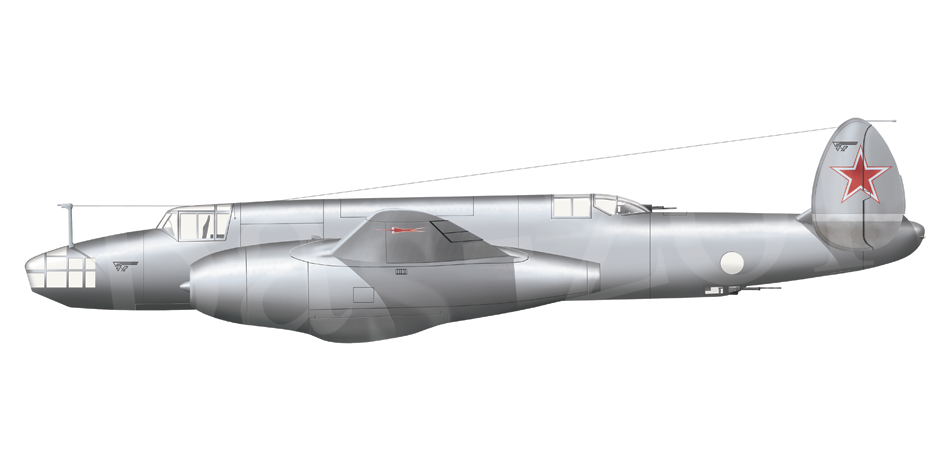
Tu-12
The Tu-12 was the last derivative of the Tu-2, but this was
not just another variant of a well-tried theme. It was also, better perhaps,
known as the Tu-77, really as a follow-on of the ANT numbering sequence. The
VVS gave it the designation Tu-12.
The Tu-12 was the Soviet Union’s first jet bomber. Tupolev
intended it as an interim measure to develop later aircraft and to train crews
in the handling of larger jet aircraft. Sergei Yeger, working under Tupolev’s
supervision, led the programme. He took the basic Tu-2 fuselage, wings and
tailplane, and adapted them only for the higher speeds of a jet. It was one of
very few jets of the 1940s to feature a twin tail. The undercarriage was
changed from a tailwheeler to a tricycle, and under the wings were fitted
Rolls-Royce Derwent engines; for several years after the war, the British
government allowed engines, and some other aviation components, to be sold to
the USSR. Although Soviet designers were hurriedly developing jet engines, by
the time of the Tu-12 in 1947 even MiG-15s were using either Rolls-Royce
engines or licence-built copies of them. Only Lyulka’s jet engines were of Soviet
design and manufacture, and these at that time had hardly half the power of the
Nenes fitted on the Tu-12, which gave a static thrust of 2,270kp/5,0041b. The
first Tu-12 was built at factory N156, the new title for the former KOSOS TsAGI
works attached to the design offices. It was completed in May 1947, and after
transfer to Zhukovski and reassembly, Aleksei Pereliot flew it on its first
flight on 27 June. There were no major difficulties found in the test
programme. For an interim aircraft its performance was reasonable: maximum
speed was 783kph/487mph, range was 2,200km/1,367 miles, and its service ceiling
was 11,300m/37,075feet. The VVS accepted the prototype Tu-12, and production
began at factory N23 in Moscow with an order for five. However, only three were
completed.
These were completed by 1950, and were used by the Air Force
in a training role for a short while. One was used as a flight test aircraft by
the LII for experimental work with rocket engines, which were mounted on a
pylon above the centre fuselage.
Tu-14
The work done on the Tu-72, -73, -74, -78 and -79 projects
were all stages in the development of Soviet jet bombers. Next step was the
Tu-81, which would later enter service with the VMS (Voenno Morskie Sili =
Navy) as the Tu-14.
Sergei Yeger was again programme leader, but the Tu-81 went
back to the twin-engined Tu-72 rather than stay with the three-engined designs
of the Tu-73, -74, -78 and -79. This came about because of Klimov’s improved
Nene/RD-45, the VK-1, which offered an increase in power from the 2,270kp/5,004lb
static thrust of the Rolls-Royce Nene and the RD-45 to 2,740kp/6,040lb, which,
combined with a lower empty weight, allowed the third engine to be omitted.
Work on the design and construction began in July 1944.
Tupolev and Yeger aimed to keep the aircraft as light as possible, so an
uncomplicated result was achieved. Still showing some considerable resemblances
to the Tu-72, the Tu-81 was a mid-winged twin-jet bomber still without wing
sweep. It was completed in factory N156 in 1948, and its first flight was made
on 13 October 1949. State tests were completed by autumn 1950, and the aircraft
was approved for production under the military designation Tu-14T for a VMS
role as a torpedo carrier.
Test results showed the Tu-14T as having a performance of
860kph/534mph, a range of 3,000km/1,864 miles, and a service ceiling of 11,200m/36,747
feet. Some eighty-seven aircraft were built in Irkutsk between 1950 and 1952,
and the first examples entered service in 1951. They were armed with two
fixed-fire NK23 cannons and two machine-guns mounted on a tail turret. It
served in a patrol role, with the ability to bomb naval targets.